Most designers looking to make a small to medium sized mobile robot quickly discover that there are very few standards in the hobby robotics industry, to the point that connecting products together is quite a complex design challenge. This article covers mostly mechanical patterns found in hubs and connectors which are available from a variety of hobby robotics parts manufacturers. Non-standard mechanical mounting would be considered products from manufacturer which release products and accessories whose mounting pattern is different from any others. We will not go into any standards used in the RC market, nor the UAV / drone industry.
Lynxmotion Servo Erector Set (SES) Pattern
The
Lynxmotion Servo Erector Set (SES) pattern is based largely on a round
Hitec standard servo horn. The center is 8mm in diameter (to fit a protrusion on the horn), and there are four 0.09" diameter holes equally spaced on a 0.656" diameter circle. These four holes can alternatively be tapped / threaded 2-56 (imperial thread). The outer diameter is 1". Pitsco's Tetrix building system also uses a variation of this pattern, sometimes with eight rather than four holes.
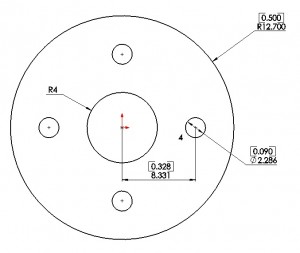 Lynxmotion SES Pattern
Lynxmotion SES Pattern
When used in structural / frame elements, the pattern is one of the following:
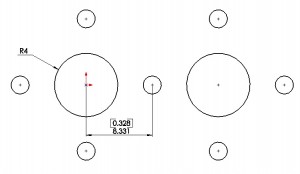 Lynxmotion Pattern 1
Lynxmotion Pattern 1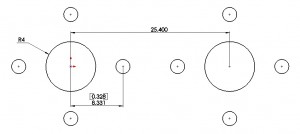 Lynxmotion Pattern 2
Lynxmotion Pattern 2ServoCity / Actobotics Hub Patterns
Actobotics® from
ServoCity is a ball bearing based precision building system. The unique overlapping hole patterns is advertised as allowing for virtually unlimited mounting possibilities, and the precision components offer structures with tight tolerances and low friction. There are currently three patterns used in this system, though at this time, only
ServoCity products incorporate these patterns, so not quite an industry standard. Nevertheless, the pattern and accessories do allow their parts to be compatible with many other "off the shelf" products.
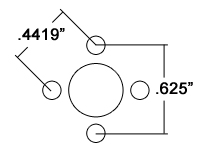 Actobotics 0.625” Hub Pattern Actobotics 0.625” Hub Pattern |
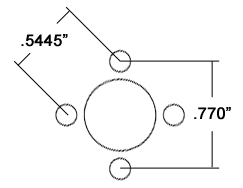 Actobotics 0.770” Hub Pattern Actobotics 0.770” Hub Pattern |
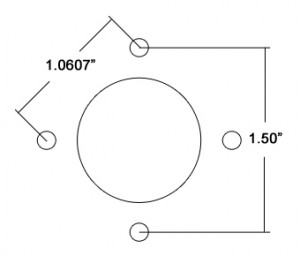 Actobotics 1.50” Hub Pattern Actobotics 1.50” Hub Pattern |
When incorporated into structural / frame elements, there is some overlap between the patterns, as is shown in the drawing below:
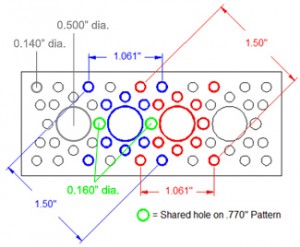 Actobotics Structural Pattern
Actobotics Structural Pattern
FIRST / Colson
This mounting pattern (no specific name) seems to have originated with FIRST robotics, though a number of additional
robotics manufacturers now use this pattern (or slight variations thereof), including
AndyMark, VEX Pro line and
Nexus Robot. Colson Caster also produces customized wheels with this mounting pattern. The pattern is six drilled holes roughly 0.2" (5mm) in diameter on a 1.875" diameter circle. The center bore varies in diameter and shape and can be metric (6mm, 8mm, 10mm, 12mm), imperial (1/4", 3/8", 1/2", 5/8"), hexagonal (mostly imperial), include a keyway. Most of the time the pattern is used on a
hub which connects a shaft to a
wheel or
sprocket. The outer diameter of the hub varies a bit between manufacturers.
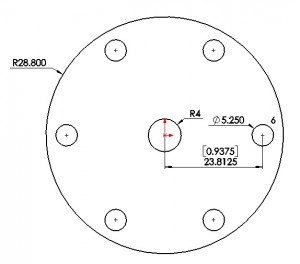 Sample FIRST-Compatible Hub (8mm bore)
Sample FIRST-Compatible Hub (8mm bore)Aluminum Extrusions
Aluminum extrusions are becoming more and more popular in robotics as they are very rigid yet lightweight, offer many ways to easily and securely mount accessories and create frames & structures. These are not robotics-specific, nor is there a specific profile aside from the outer dimensions, though a number of manufacturers have based their designs on this pattern.
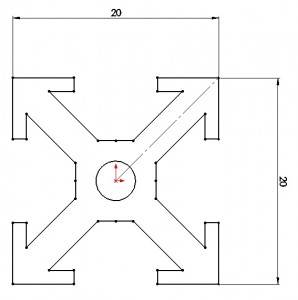 Generic 20mm x 20mm Profile
Generic 20mm x 20mm Profile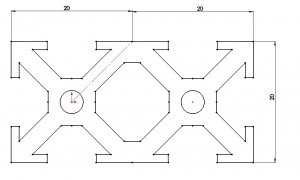 Generic 40mm x 20mm Profile
Generic 40mm x 20mm ProfileRC Servo Splines
The most popular
RC servos used in hobby robotics are from
Hitec and
Futaba (as well as JR), and the servos which offer the greatest value tend to be the most popular. "Hitec standard" servos include the
HS-322,
HS-422,
HS-645MG,
HS-1425CR among others. The output shaft is not round but rather "splined" (similar though not identical to a gear). "Futaba standard" servos include the S3001,
S3004 etc. Once cannot assume that all
RC servos use the same spline; even within the same series from the same manufacturer, the output spline can differ in diameter, number of teeth, pitch etc. A number of
robotics manufacturers base their core products on Hitec or Futaba servos, which means that when their
servo attachments / accessories need to connect directly to a servo spline, they tend to use either Hitec or Futaba standard, to allow for the greatest versatility.
HITEC Splines
|
Description |
Examples |
| A1 |
Sub-Micro |
HS-50, HS-55... |
| B1 |
Mini |
HS-125MG, HS-65HB... |
| C1 |
Standard |
HS-322, HS-422, HS-755HB... |
| H25T |
Futaba Standard |
HS-83xxTH, HSB-93xxTH |
| D1 |
Heavy Duty |
HS-805BB, HS-815BB... |
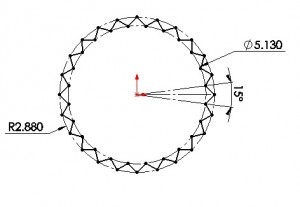 Example: Hitec C1 Type 24T Spline
Example: Hitec C1 Type 24T SplineFUTABA Splines
|
Description |
Examples |
| 1F |
Micro |
S3111, S3114, S3154... |
| 2F |
Small |
S3153, S3107, S117... |
| 3F |
Medium |
S3001, S3004... |
| 4F |
Large |
S3306, S9154 |
Spur Gear Motors
We have found a number of
DC spur gear motor manufacturers use the same front mounting pattern. The pattern is normally comprised of three threaded holes, spaced at 120 degrees to each other, on a 31mm diameter circle. The threading is often M3 (metric 3mm). The shaft diameter for these motors is often 6mm.
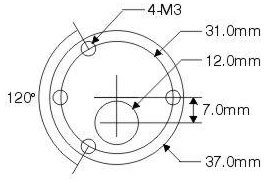 Spur Gear Profile
Spur Gear ProfileManufacturer Specific Patterns
There are certain manufacturers of robots /
robot parts which have decided to make a mounting pattern which is different than any other on the market. As such, it is very difficult to create a standard around them. Some examples of these include:
LEGO Mindstorms
The mounting pattern used in the
LEGO Mindstorms series of robot building kits is based on the normal LEGO building blocks as well as the LEGO Technic pattern. Although there are a variety of other manufacturers which create
LEGO-compatible accessories such as
sensors,
wheels and
actuators which are compatible with LEGO Mindstorms, it is difficult to say that the LEGO pattern is a standard in the hobby robot market.
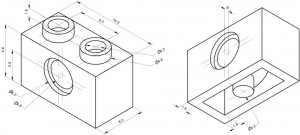 LEGO Brick Dimensions Example
LEGO Brick Dimensions ExampleVEX
Innovation FIRST's
VEX EDR platforms uses a square mounting pattern for both the frames and the shafts. This means that products like their
wheels,
gears,
motors and other accessories are really only compatible with this pattern. As such,
VEX parts & accessories can only really be used with
VEX kits, which is why it is rare to find hobby robot builders using them on their robots. Fortunately
VEX offers a very diverse range of accessories. However, because of the very low cost of some of these accessories, most notably their wheels, certain builders are prepared to hack the products or customize their system to make the parts semi-compatible.
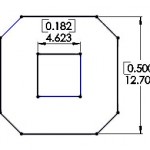 VEX EDR Square Pattern
VEX EDR Square Pattern
Are there mechanical patterns which you have found are used by more than one supplier and would like to share? Add your comments below and we will periodically update this article.
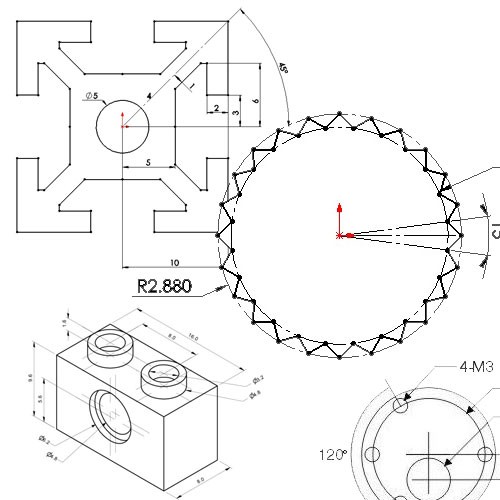
 Actobotics Structural Pattern
Actobotics Structural Pattern
 Spur Gear Profile
Spur Gear Profile
 Actobotics 0.625” Hub Pattern
Actobotics 0.625” Hub Pattern Actobotics 0.770” Hub Pattern
Actobotics 0.770” Hub Pattern Actobotics 1.50” Hub Pattern
Actobotics 1.50” Hub Pattern Actobotics Structural Pattern
Actobotics Structural Pattern Spur Gear Profile
Spur Gear Profile










